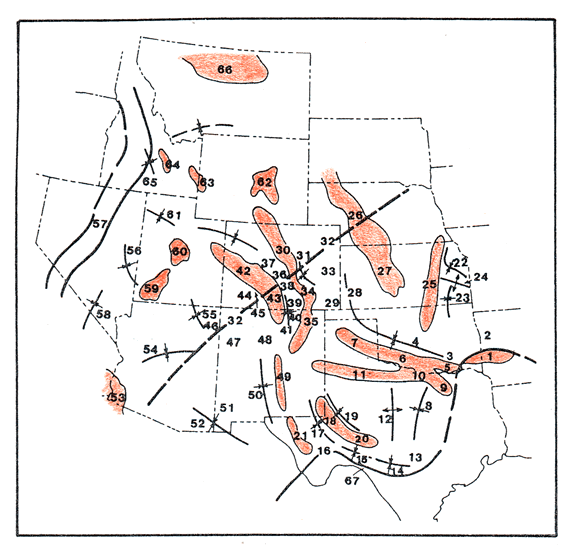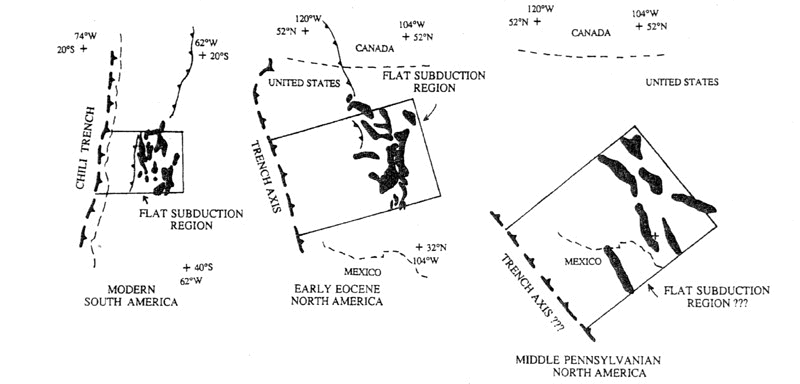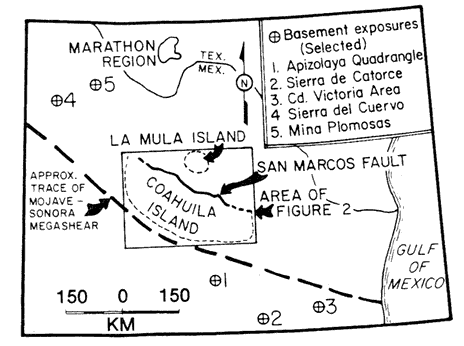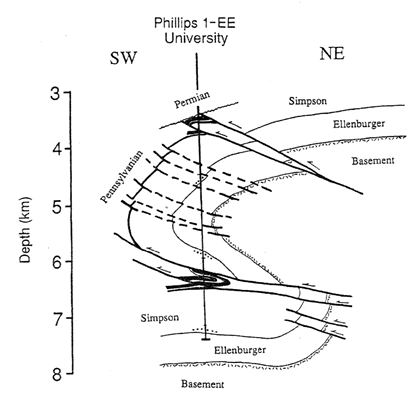Andean Subduction Along the Southwest Margin of North America
Evidence of a Pennsylvanian-Permian volcanic arc in northeastern Mexico has promted Ye et al. (1996) to reevaluate the possible tectonic origins of the Ancestral Rocky Mountains. A subduction zone along the southwestern margin of late Paleozoic North America would run contrary to the popular hypothesis of a passive western margin during the Pennsylvanian and Permian periods. Ye et al. argue that intracratonic stresses produced by the Ouachita-Marahon orogeny would be insufficient and incorrectly oriented to produce the structures observed in the greater Ancestral Rocky Mountain region. Instead, NE-directed compressional forces from a NE-dipping subduction boundary in the southwest produced basement-involved thrust faults trending generally NW-SE.
The Las Delicias basin in central Coahuila, Mexico (Figure 1), contains late Paleozoic marine sedimentary rocks that accumulated adjacent to a volcanic arc (McKee, Jones, and Anderson, 1988). Abundant mass-gravity deposits in the basin contain andesitic and dacitic volcanic debris ranging from sand-sized grains to blocks that are a few hundreds of meters in diameter. The ages of volcaniclastic strata were derived from fusilinids in limestone clasts of contemporaneous basin-margin shelf deposits. The volcanic arc that produced this debris appears to have been active from the mid-Pennsylvanian through the Permian.
Figure 1 - The Las Delicias basin and volcanic arc lie within the Coahuila Island, bound on the north by the San Marcos fault and on the south by the Mohave-Sonora megashear. From McKee, Jones, and Anderson, 1988.
Ye et al. (1996) interpret these volcanic deposits as originating from an Andean-type volcanic arc that erupted through continental crust, implying a NE-dipping slap of oceanic lithosphere subducting beneath the North American plate margin. To evaluate their hypothesis in comparison to the Ouachita-Marathon hypothesis, they cite the relative timing of deformation, orientation of regional strain fields, structural relationships of tectonic trends, and the existence of modern analogs that allow an analysis of intraplate deformation due to events at plate margins.
The Ouachita-Marathon thrust belt is a series of thin-skinned structures that lack extensive involvement of the crystalline basement, display no high-grade metamorphism, show low paleo-elevations and erosion rates, and lack large amounts of shortening of continental crust. The orogen is usually regarded as the result of continent-continent collision during the assembly of Pangea, but Ye et al. (1996) claim that the geologic features are better explained as those of an accretionary prism obducted onto the edge of North America. Geology of the Ouachita-Marathon area closely coincides with that of several thrust belts in the Mediterranean region, where Eurasia and Africa-Arabia are colliding (Figure 2). The Carpathian, Apennine, and Hellenic thrust belts are characterized by low-grade to no metamorphism, small amounts of denudation, and little to no involvement of crystalline basement in shortening. Thrusting appears to stop when the thrust belt is emplaced onto a cratonic foreland. Subduction in these belts does not involve large horizontal compressive stresses but is instead driven by slab pull and is accompanied by extension in the upper plate that is parallel to the direction of subduction. These similarities suggest that the Ouachita-Marathon orogen occurred where collision of thick continental crust had not yet taken place but was an accretionary-type thrust. It is therefore unlikely that large amounts of compressional stress could have been transmitted into the intractratonic foreland region of the Ouachita-Marathon orogen.

Figure 2 - Mediterranean tectonic setting, showing locations of the Appenine, Carpathian, and Hellenic thrust belts. From Ye et al. (1996).
An analysis of basin stratigraphy and seismic profiles suggests to Ye et al. (1996) that the dominant mode of deformation within the Ancestral Rocky Mountain region was basement-involved overthrusting. A drill hole along the southwestern margin of the Uncompahgre uplift (#42, Figure 3) in southwestern Colorado penetrated overturned Paleozoic rocks beneath 4 km of Precambrian basement rock, evidence that the Uncompahgre uplift was thrust southwestward over the Paradox basin (#44, Figure 3). A zone of northeastward thrusting along the northeastern margin of the Uncompahgre uplift is inferred as being concurrently active as is southwestern margin on the basis of flexural subsidence of the Central Colorado trough. West-vergent basement thrusting along the west side of the Pedernal uplift (#49, Figure 3) is suggested by the basinward (westward) migration of facies boundaries during the late Pennsylvanian, the eastward deepening of the Orogrande basin (#50, Figure 3), and folding and faulting along the east side of the basin.

Figure 3 - Uplifts, basins, and other tectonic features of late Paleozoic western North America. From Kluth (1986).
Seismic data and well-log data show evidence for basement-involved thrusting in structures further to the southeast, as well. Well data drilled through the Central basin platform (#18, Figure 3) show that the Delaware basin (#17, Figure 3) formed during southwest-directed thrusting of the Central basin platform over the basin (Figure 4). The Wichita-Amarillo uplift (#6, 7, Figure 3) was produced by basement thrusting over the Anadarko basin, made evident by northeast-vergent asymmetric folds, thrust faults propagating into the basin, and seismic reflectors dipping towards the southwest with an estimated displacement of 10-20 km along the thrust fault.
Figure 4 - Interpreted structural section through the Phillips 1-EE University well in the southwestern Central basin platform. Ellenburger and Simpson formations are lower to mid-Paleozoic. No vertical exaggeration. From Ye et al. (1996).
The style of deformation and the orientation of basins and uplifts in the greater Ancestral Rocky Mountain region suggests a dominant northeast-southwest direction of compression during the late Paleozoic. Ye et al. (1996) state that it is therefore unlikely that convergence along the Appalachian orogen or the Ouachita-Marathon orogen caused the deformation of the Ancestral Rockies. Compressional stresses generated across a northwest-trending, northeast-dipping subduction zone along the southwestern margin of North America would be consistent with the structures and shortening directions within the Ancestral Rockies. The inferred volcanic arc in northeastern Mexico is cited as evidence that the Ancestral Rockies formed due to basement-involved shortening within the hinterland of an active Andean margin.
The final evidence provided by Ye et al. (1996) lies in two analogs that involve intraplate shortening along an Andean margin (Figure 5). The first is the late Cretaceous-early Cenozoic Laramide Orogeny that created the modern Rocky Mountains of the western United States. The second is the Cenozoic shortening along the east side of the Sierra Pampeanas in the Argentine Andes. Both examples involve intraplate shortening distributed across a region over 500 km wide and over 500 km from the subduction boundary, with the downgoing slab oriented at a very shallow angle.

Figure 5 - Two analogs arguing for an Andean subduction margin during the Pennsylvanian period in southwestern North America. From Ye et al. (1996).




